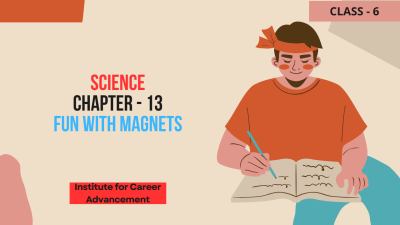Course description
Here's a comprehensive overview of what students typically learn in this course:
1. Introduction to Magnets:
Nature of Magnets: Understanding magnets as objects that produce magnetic fields and attract certain materials like iron, nickel, and cobalt.
Types of Magnets: Differentiating between permanent magnets (e.g., bar magnets, horseshoe magnets) and temporary magnets (e.g., electromagnets).
2. Magnetic Properties and Behaviors:
Magnetic Poles: Identifying the north and south poles of a magnet and understanding how opposite poles attract and like poles repel each other.
Magnetic Fields: Exploring the concept of magnetic fields and how they extend around magnets, influencing nearby objects.
3. Magnetic Materials:
Magnetic and Non-magnetic Materials: Distinguishing between materials that are attracted to magnets (ferromagnetic) and those that are not (non-magnetic).
Applications: Exploring practical applications of magnetic materials in everyday objects, such as refrigerator magnets and magnetic toys.
4. Magnetic Forces and Interactions:
Force of Attraction and Repulsion: Conducting experiments to observe how magnets attract or repel each other based on their orientations and distances.
Magnetic Induction: Investigating how magnets induce temporary magnetism in nearby objects without physical contact.
5. Magnetic Compass:
Navigation: Understanding the historical significance of magnetic compasses in navigation and their role in determining directions (north, south, east, west).
Earth's Magnetic Field: Introducing Earth's magnetic field and its influence on compass needles.
6. Electromagnetism:
Electromagnets: Constructing simple electromagnets using a coil of wire and a battery, and observing how they attract magnetic materials when current flows through the coil.
Applications: Exploring practical uses of electromagnets in devices such as electric bells, cranes, and MRI machines.
এই কোর্সে শিক্ষার্থীরা সাধারণত কী শিখে তার একটি বিস্তৃত ওভারভিউ এখানে রয়েছে:
1. চুম্বকের ভূমিকা:
চুম্বকের প্রকৃতি: চুম্বককে বস্তু হিসাবে বোঝা যা চৌম্বক ক্ষেত্র তৈরি করে এবং লোহা, নিকেল এবং কোবাল্টের মতো নির্দিষ্ট পদার্থকে আকর্ষণ করে।
চুম্বকের প্রকারভেদ: স্থায়ী চুম্বক (যেমন, বার চুম্বক, ঘোড়ার চুম্বক) এবং অস্থায়ী চুম্বক (যেমন, ইলেক্ট্রোম্যাগনেট) এর মধ্যে পার্থক্য করা।
2. চৌম্বকীয় বৈশিষ্ট্য এবং আচরণ:
চৌম্বক মেরু: চুম্বকের উত্তর ও দক্ষিণ মেরু চিহ্নিত করা এবং বিপরীত মেরুগুলি কীভাবে একে অপরকে আকৃষ্ট করে এবং খুঁটির মতো তা বোঝা যায়।
চৌম্বক ক্ষেত্র: চৌম্বক ক্ষেত্রের ধারণা এবং কীভাবে তারা চুম্বকের চারপাশে প্রসারিত হয়, কাছাকাছি বস্তুগুলিকে প্রভাবিত করে তা অন্বেষণ করা।
3. চৌম্বকীয় উপাদান:
চৌম্বক এবং অ-চৌম্বকীয় পদার্থ: চুম্বক (ফেরোম্যাগনেটিক) এবং যেগুলি নয় (অ-চৌম্বক) এর প্রতি আকৃষ্ট হয় এমন পদার্থের মধ্যে পার্থক্য করা।
অ্যাপ্লিকেশন: প্রতিদিনের বস্তুতে চৌম্বকীয় পদার্থের ব্যবহারিক প্রয়োগের অন্বেষণ, যেমন রেফ্রিজারেটর চুম্বক এবং চৌম্বকীয় খেলনা।
4. চৌম্বক বল এবং মিথস্ক্রিয়া:
আকর্ষণ এবং বিকর্ষণ শক্তি: চুম্বকগুলি তাদের অভিযোজন এবং দূরত্বের উপর ভিত্তি করে কীভাবে একে অপরকে আকর্ষণ বা বিকর্ষণ করে তা পর্যবেক্ষণ করার জন্য পরীক্ষা পরিচালনা করা।
চৌম্বক আবেশ: চুম্বক কিভাবে শারীরিক যোগাযোগ ছাড়াই কাছাকাছি বস্তুতে অস্থায়ী চুম্বকত্বকে প্ররোচিত করে তা তদন্ত করা।
5. চৌম্বক কম্পাস:
ন্যাভিগেশন: ন্যাভিগেশনে চৌম্বকীয় কম্পাসের ঐতিহাসিক তাত্পর্য এবং দিকনির্দেশ (উত্তর, দক্ষিণ, পূর্ব, পশ্চিম) নির্ধারণে তাদের ভূমিকা বোঝা।
পৃথিবীর চৌম্বক ক্ষেত্র: পৃথিবীর চৌম্বক ক্ষেত্র এবং কম্পাস সূঁচের উপর এর প্রভাবের পরিচয়।
6. ইলেক্ট্রোম্যাগনেটিজম:
ইলেক্ট্রোম্যাগনেট: তারের কয়েল এবং একটি ব্যাটারি ব্যবহার করে সাধারণ ইলেক্ট্রোম্যাগনেট তৈরি করা এবং কয়েলের মধ্য দিয়ে বিদ্যুৎ প্রবাহিত হলে তারা কীভাবে চৌম্বকীয় পদার্থকে আকর্ষণ করে তা পর্যবেক্ষণ করা।
অ্যাপ্লিকেশন: বৈদ্যুতিক ঘণ্টা, ক্রেন এবং এমআরআই মেশিনের মতো ডিভাইসগুলিতে ইলেক্ট্রোম্যাগনেটের ব্যবহারিক ব্যবহার অন্বেষণ করা।



















